Which royal family’s tiara collection would cost the most to insure?
How much would royals around the world need to spend to insure their crown jewels? The insurance experts at money.co.uk studied the policy costs for tiaras worn by royals all over the globe to estimate which royal is paying the most to keep their jewels safe.

From the UK’s Queen Elizabeth II to Spain’s Queen Letizia to Margrethe II of Denmark, famous royals have long been known for their vast collection of valuable jewelry. But just how much would they need to pay to insure their tiara collections?
To find out, we created a list of eight countries around Europe with active royal families and identified their three most recently worn wedding tiaras. Each tiara was then valued by experts at StevenStone.co.uk, before we created an insurance estimate based on the age of the royal family member and the estimated cost of each tiara.
We totalled these figures per country to identify how much each royal family could potentially spend protecting their tiara collection, before being ranked*.
If you own expensive jewellery or high value items, it's important to find out if they are covered by your contents insurance. If you’re a homeowner and own the freehold, you might want to compare home insurance where your buildings and contents insurance are on a combined policy. Not only can it be the best home insurance, UK providers often offer cheaper premiums compared to having separate policies.
Which royal family’s tiara collection would cost the most to insure?
The United Kingdom (£297,466 per annum)
We can reveal that the country that would need to spend the most on insuring their tiara collection is the United Kingdom. According to Steven Stone, the total cost of the royal family’s three most recently worn wedding tiaras comes to £17 million, which means they could cost around £297,466 a year to insure.
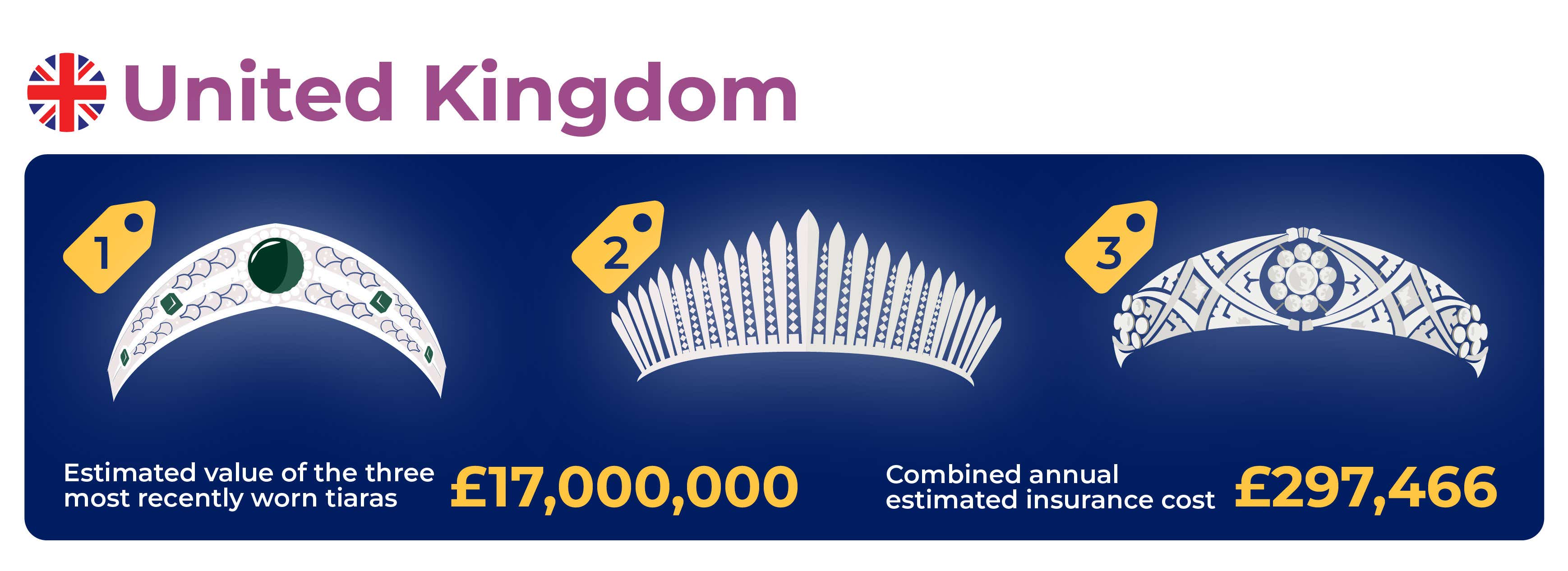
1. Greville Emerald Kokoshnik Tiara
Valued at £10 million
Worn by Princess Eugenie of York when marrying Jack Brooksbank on 12 October 2018.
The Greville Emerald Kokoshnik tiara is made of rose-cut pave diamonds set in platinum and is adorned with six emeralds. The centre features a 93.7-carat cabochon-cut emerald.
The distinctive diamond and emerald headpiece, made by the French jeweller Boucheron in 1919, is estimated to be worth £10 million – the most expensive of all the tiaras studied. Our analysis concludes that it could potentially cost the royal family £174,980 to insure annually.
2. Queen Mary Fringe Tiara
Valued at £5 million
Worn by Princess Beatrice of York when marrying Edoardo Mapelli Mozzi on 17 July 2020.
The Queen Mary Fringe Tiara comprises 47 diamond bars with alternating smaller diamond spikes. It is set in gold and silver and was crafted in 1919 by the British jewellers Garrard and Co. using a diamond necklace that was given to Queen Mary on her wedding day in 1893. It is of particular importance to the British royal family as it is the same headpiece Queen Elizabeth II wore when she married the Duke of Edinburgh in 1947.
This tiara is estimated to be worth in the region of £5 million, which means it could cost the royal family £87,490 to insure each year.
3. Queen Mary's Diamond Bandeau Tiara
Valued at £2 million
Worn by Meghan Markle when marrying Prince Harry on 19 May 2018.
Queen Mary’s Diamond Bandeau Tiara is set with large and small diamonds in a geometric design. The centre stone on the headpiece is a detachable 10-diamond brooch, gifted to Queen Mary on her wedding day in 1893, making the tiara dual purpose.
The tiara was used for the first time in 65 years when worn by Meghan Markle on her big day in 2018. It is estimated to be worth in the region of £2 million, so we estimate the tiara could cost the British monarchy £34,996 annually to insure.
The Netherlands (£266,769 per annum)
The Dutch royal family would need to spend the second most to insure their tiara collection. Steven Stone estimates the total value of the royal family’s three most recently worn wedding tiaras could add up to a figure in the region of £17 million. We estimate the tiaras could cost around £266,769 to insure each year.
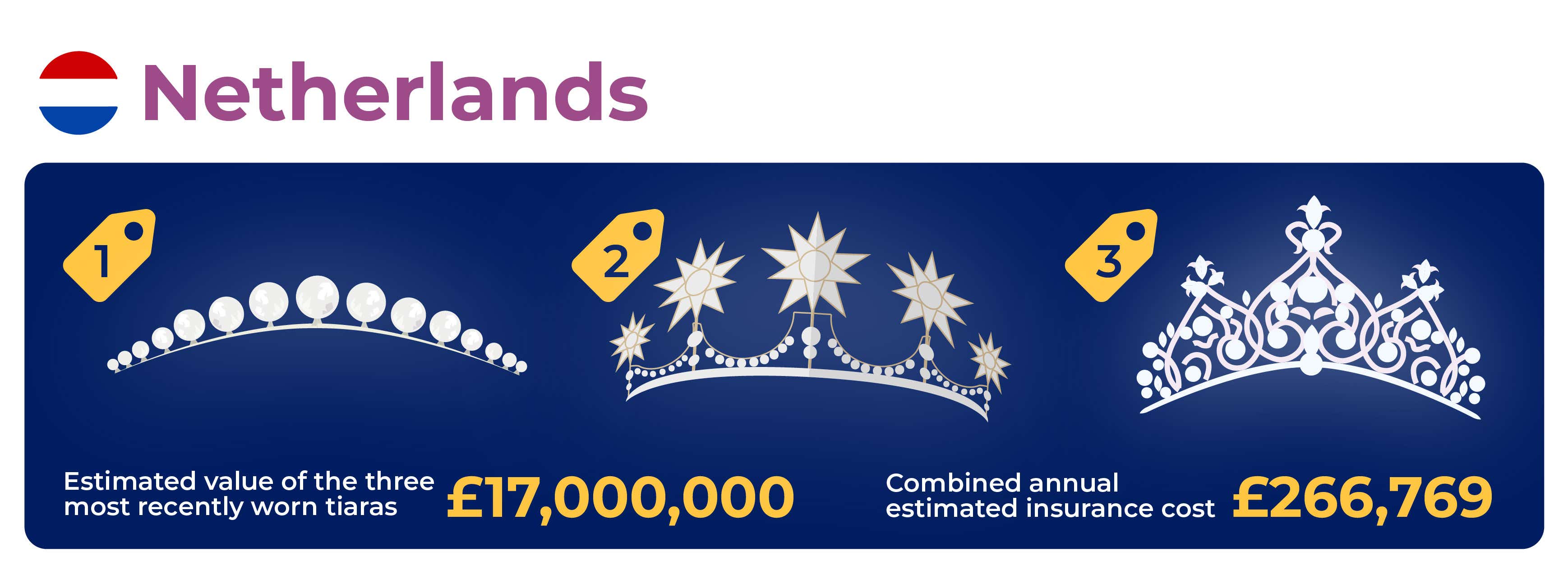
1. Rose Cut Diamond Bandeau Tiara
Valued at £8 million
Worn by Queen Juliana when marrying Prince Bernhard of Lippe-Biesterfeld on 7 January 1937.
The Rose Cut Diamond Bandeau Tiara, also known as the Dutch Diamond Bandeau, was created in 1937. The headpiece was made using 34 large diamonds from a necklace belonging to Queen Juliana’s grandmother, Queen Emma. All-in-all, the diamonds adorned across the bandeau weigh more than 100 carats.
The tiara is estimated to be worth around £8 million and could cost the royal family around £125,538 annually to insure.
2. The Dutch Star Tiara
Valued at £5 million
Worn by Queen Maxima when marrying Willem-Alexander of the Netherlands on 2 February 2002.
Queen Maxima created the Dutch Star Tiara for her wedding day using two different pieces of existing royal jewellery. The monarch utilised the base of the existing Dutch Pearl Button Tiara, but rather than pearl buttons added five diamond stars belonging to Queen Emma.
Our expert valued this elegant tiara at £5 million, which means it could potentially cost the royal family £78,461 to insure per annum.
3. The Württemberg Tiara
Valued at £4 million
Worn by Queen Beatrix when marrying Prince Claus of the Netherlands on 10 March 1966.
In 1897, the ornate Württemberg Pearl Tiara was created for Queen Wilhelmina prior to her inauguration ceremony to become the Dutch monarch. The headpiece, which is set with diamonds, features 35 round pearls and 11 pear-shaped pearls. The tiara can be worn in four separate settings, making it highly versatile for different royal events.
This tiara has been valued at around £4 million, which means that the Dutch royal family would need to spend around £62,769 insuring this tiara each year.
Norway (£243,230 per annum)
Norway’s three most recently worn royal wedding tiaras are estimated to be worth around £15.5 million, which is the third highest valuation of the eight countries studied. As a result, we estimate the three tiaras could cost around £243,230 to insure each year.
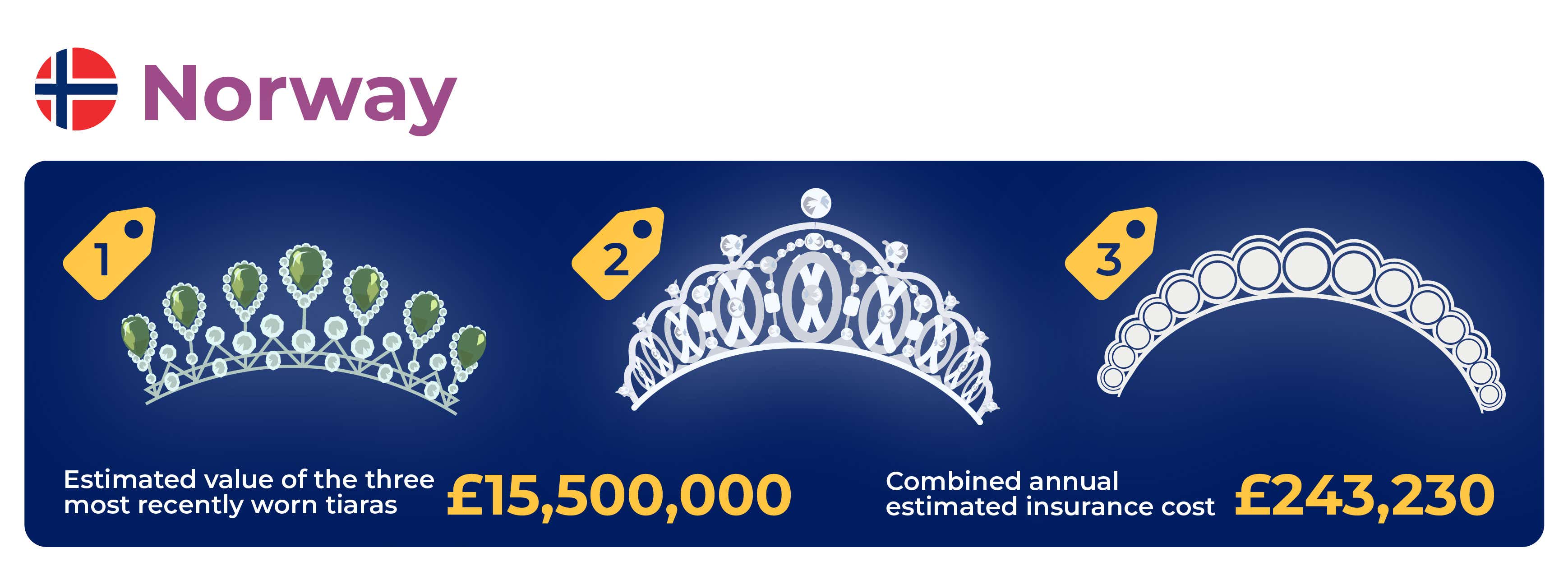
1. Queen Maud’s Diamond Tiara
Valued at £10 million
Worn by Princess Maud when marrying Haakon VII of Norway on 22 July 1896.
The tri-level diamond tiara, made by Carrington, is the biggest in the Norweigan royal collection. A level of diamond floral elements sits atop a diamond bandeau base, with a row of 13 diamond buttons on the top.
Our experts expect this tiara to be worth around £10 million, which means it could potentially cost the Norweigan royal family £156,923 to insure each year.
2. Vasa Tiara
Valued at £5 million
Worn by Princess Märtha when marrying Ari Behn on 24 May 2002.
The Vasa Tiara takes its name from the Vasa family heraldic crest that is the central design of the tiara. The Vasa family ruled Sweden from 1523 to 1654, but the tiara was gifted to the Norwegian royal family by the city of Stockholm when Princess Märtha of Sweden married the future King Olav V of Norway in 1929.
Made in 1929 by CF Carlman, the headpiece features a crown set with 956 diamonds weighing 49.5 carats, white solitaires in a blue-white motif crown, and four-carat solitaire diamonds. Estimated to be worth an impressive £5 million, the tiara could cost the royal family £78,461 to protect annually.
3. The Diamond Daisy Bandeau Tiara
Valued at £500,000
Worn by Mette-Marit Tjessem Høiby when marrying Haakon, Crown Prince of Norway on 25 August 2001.
As the name suggests, the Diamond Daisy Bandeau Tiara showcases 23 floral rosettes made out of diamonds. The tiara, created in 1910, has become a signature piece of jewellery for Princess Mette-Marit of Norway after her parents-in-law gifted it to her on her wedding day.
The delicately designed tiara has an estimated value of £500,000, which means it could potentially cost the Norweigan royal family £7,846 to insure per annum.
Denmark (£172,615 per annum)
The country spending the fourth most insuring their tiara collection is Denmark. Steven Stone have given the royal family’s three most recently worn wedding tiaras an estimated value of £11 million, which means they could cost around £172,615 to insure each year.
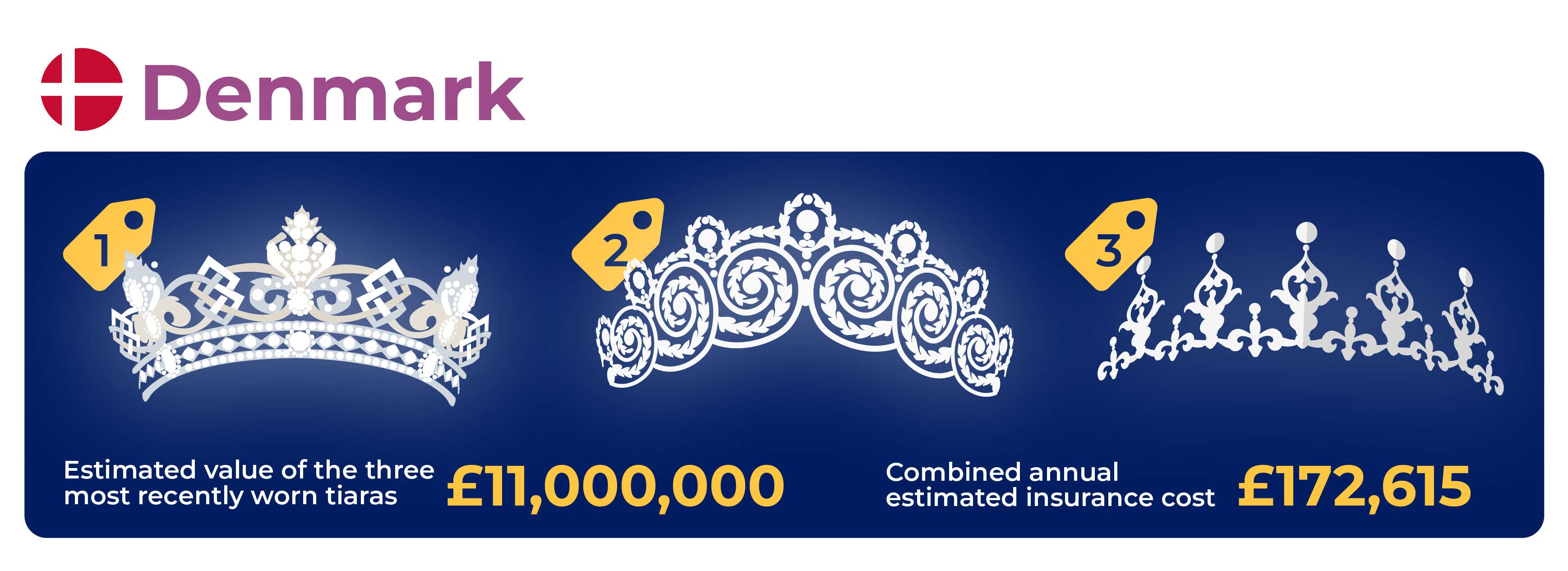
1. The Rundell Tiara
Valued at £7.5 million
Worn by Princess Alexandra of Denmark when marrying Edward VII on 10 March 1863.
The Rundell Tiara, created by Garrard in 1862, has three rows of diamonds on a solid base with interchangeable elements on the top. It is most commonly worn with large diamond fleur-de-lys elements. The tiara is part of a larger diamond and pearl parure including a necklace, a brooch and a pair of earrings, and was a wedding gift from the Prince of Wales (future King Edward VII) to Princess Alexandra of Denmark in 1863.
The tiara is estimated to be worth £7.5 million, which could cost the royal family approximately £117,692 to insure per year.
2. The Khedive of Egypt Tiara
Valued at £2.5 million
Worn by Queen Margrethe when marrying Henrik, Prince Consort of Denmark on 10 June 1967.
The Khedive of Egypt Tiara, also known as the Cartier Wreath Scroll Tiara, features an intricate spiral design. It was a gift to Queen Margrethe II from the Khedive of Egypt, who commissioned Cartier to create the headpiece as a wedding gift.
The tiara is estimated to be worth £2.5 million, which means an annual insurance cost of approximately £39,231 for the royal family.
3. Crown Princess Mary's Wedding Tiara
Valued at £1 million
Worn by Mary Donaldson when marrying Frederik, Crown Prince of Denmark on 14 May 2004.
Crown Princess Mary’s Wedding Tiara features five prominent peaks with six smaller diamond prongs in between, creating a diamond heart and fleur-de-lys shapes. The tiara’s diamond tips can be switched for pearls depending on the desired look.
The tiara, a gift from Crown Princess Mary's new parents-in-law, is valued at approximately £1 million and could potentially cost the Danish royals £15,692 a year to insure.
Belgium (£166,338 per annum)
Despite having a modest tiara collection, the Belgian royal family could spend the fifth highest sum insuring their tiara collection. Steven Stone have valued the three most recently worn wedding tiaras at an estimated £10.6 million, which means they have an estimated combined insurance premium of £166,338 per annum.
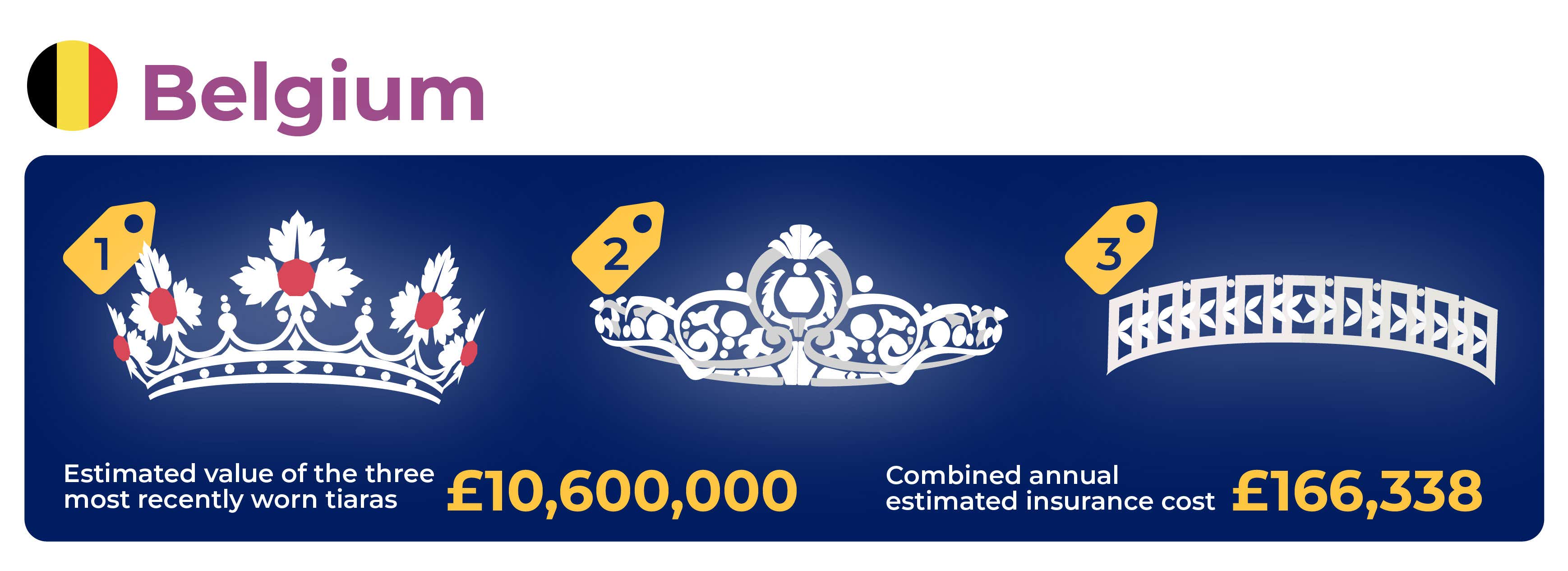
1. The Spanish Wedding Gift Tiara
Valued at £5 million
Worn by Princess Fabiola de Mora y Aragon when marrying Baudouin of Belgium on 15 December 1960.
As the name suggests, the Spanish Wedding Gift Tiara was a wedding present for Queen Fabiola of Belgium from the then-leader of Spain, Generalissimo Franco. The headpiece can be worn in three different ways, with the centre of each diamond leaf element studded with either rubies, emeralds, or aquamarines.
The tiara is estimated to be worth £5 million, which means it could potentially cost the royal family £78,461 each year to insure.
2. Belgian Scroll Tiara
Valued at £5 million
Worn by Princess Josephine-Charlotte when marrying Jean, Grand Duke of Luxembourg on 9 April 1953.
The Belgium Scroll Tiara, made of diamonds set in platinum with palmette, crescent, and scroll motifs, was created by Henry Coosemans in 1953. Like many royal jewels, the tiara is dual purpose as the largest central diamond is detachable and can also be worn as a ring.
The tiara has been valued at £5 million, which means it could cost the Belgian royal family approximately £78,461 to insure per annum.
3. Queen Elisabeth of Belgium Art Deco Bandeau Tiara
Valued at £600,000
Worn by Princess Mathilde d'Udekem d'Acoz when marrying Philippe of Belgium on 4 December 1999.
Made in the early 20th century, the Queen Elisabeth of Belgium Art Deco Bandeau Tiara features a simplistic zig-zag design with round diamonds and a laurel wreath. Like many royal headpieces, it is multifunctional and can also be worn as a necklace.
Valued at £6 million, this small bandeau tiara could cost the royal family £9,415 to insure annually.
Spain (£117,692 per annum)
Steven Stone valued Spain’s three most recently worn royal wedding tiaras at £7.5 million, which is the sixth highest valuation of the eight countries studied. This means that all three tiaras combined could potentially cost the Spanish royal family an estimated £117,692 to insure each year.
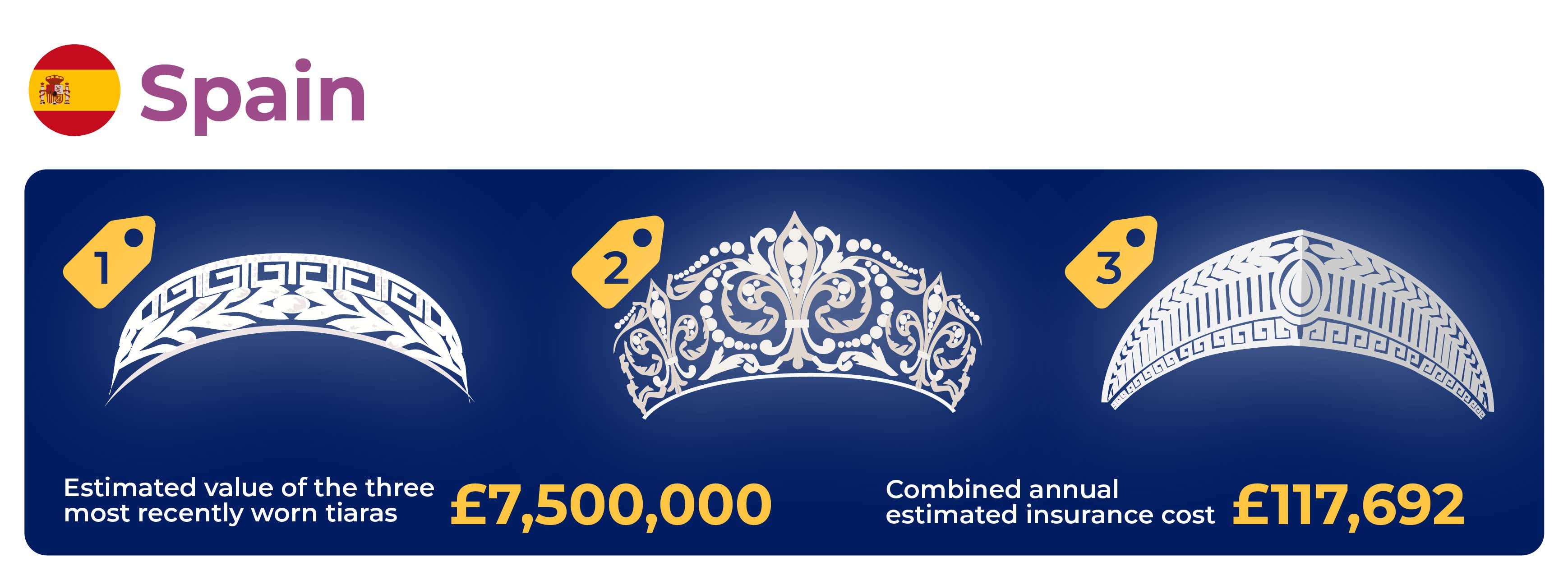
1. The Marichalar Meander Tiara
Valued at £3 million
Worn by Infanta Elena Maria when marrying Jaime de Marichalar on 18 March 1995.
The Marichalar Meander Tiara combines various classical motifs in a kokoshnik-inspired shape. It features diamonds and platinum with a base of metal circles, a laurel wreath in the middle, and a meander at the top.
The headpiece, given to Infanta Elena of Spain as a wedding present by her husband and mother-in-law, is estimated to be worth £3 million. This means the Spanish royals would need to spend an estimated £47,077 to insure it per annum.
2. Fleur de Lys Tiara
Valued at £2.5 million
Worn by Princess Victoria Eugenie of Battenberg when marrying Alfonso XIII on 31 May 1906.
Queen Victoria Eugenie of Spain's Fleur de Lys Tiara, made by court jeweller Ansorena in 1906, has become the most important tiara in the Spanish royal family. The headpiece, gifted by Alfonso XIII on their wedding day, is covered in large round diamonds set in platinum and features three large fleur-de-lys motifs.
Our expert has valued the tiara at around £2.5 million, which means it could potentially cost the royals £39,231 annually to insure.
3. The Prussian Diamond Tiara
Valued at £2 million
Worn by Queen Letizia Ortiz when marrying Felipe VI on 22 May 2004.
The Prussian (or Hellenic) Diamond Tiara is a small diamond and platinum kokoshnik made by German court jeweller Koch in 1905. The tiara features a band of laurel leaves crowning the top of the tiara, resting on gem-set columns and a meander base. The star of the show is the swinging pear-shaped diamond pendant in the centre of the tiara that moves with the wearer.
Valued at an estimated £2 million by our expert, the tiara could potentially cost the Spanish royal family £31,385 to insure each year.
Sweden (£86,830 per annum)
The total cost of the Swedish royal family’s three most recently worn wedding tiaras is estimated at just over £5 million by Steven Stone, which we believe could cost the royals around £86,830 to insure each year.
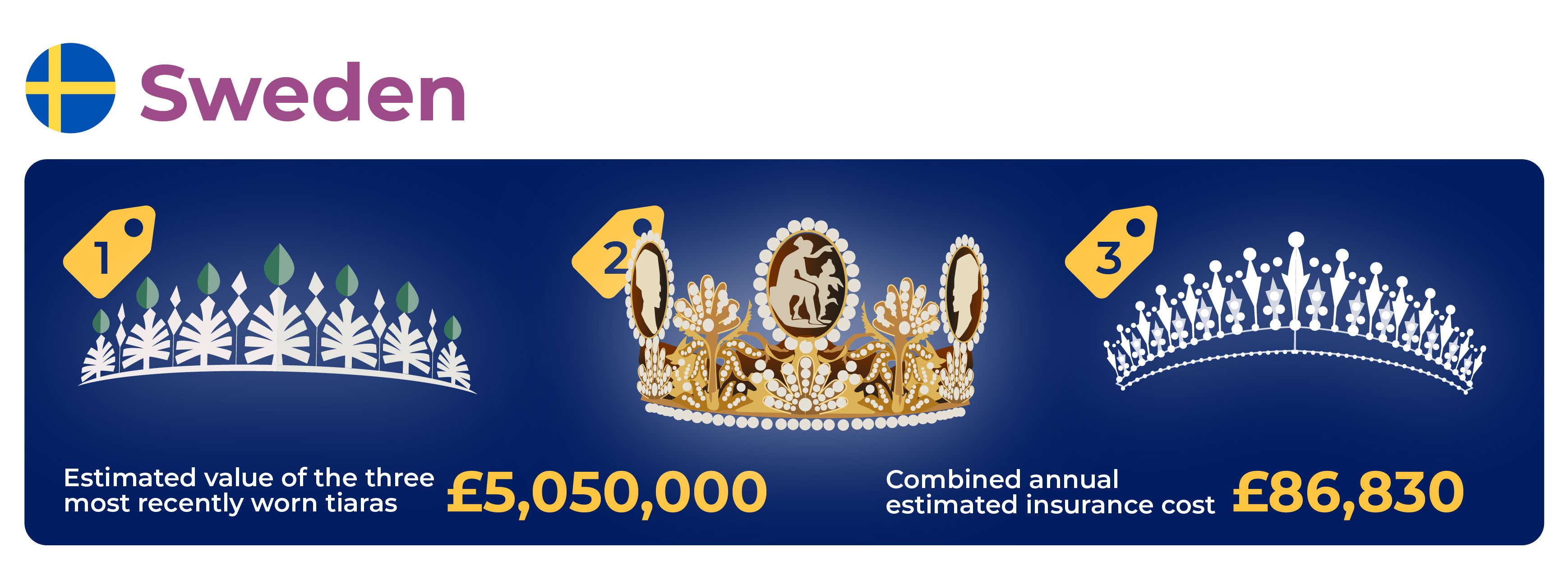
1. Palmette Tiara
Valued at £4 million
Worn by Princess Sofia Hellqvist when marrying Prince Carl Philip, Duke of Värmland on 13 June 2015.
Sweden’s Palmette Tiara features diamond palmettes set on a diamond-studded base and is interspersed with diamond spikes. Originally, Sofia wore the tiara with a set of emerald toppers, however over the years pearl and blue toppers have been worn too.
The extravagant headpiece, worn by Princess Sofia in June 2015 when she married Prince Carl Philip of Sweden, is estimated to be worth £4 million. Our analysis found it could set the Swedish royal family back £69,992 to insure it each year.
2. Cameo Tiara
Valued at £850,000
Worn by Crown Princess Victoria of Sweden when marrying Prince Daniel, Duke of Västergötland on 19 June 2010.
Believed to be one of the oldest tiaras still in use, the Cameo Tiara is part of a 19th-century parure including a pair of earrings, a necklace, a brooch and a bracelet. Each cameo is set in yellow gold and surrounded by pearls, with pearl floral motifs embellished across the headpiece. The cameos feature Venus, the goddess of beauty and love, and her son, Cupid, god of passion and desire.
Despite not holding a single diamond, the tiara is estimated to be worth £850,000. According to our analysis, insuring this unusual headpiece could cost £13,338 each year.
3. Modern Fringe Tiara
Valued at £200,000
Worn by Princess Madeleine, Duchess of Hälsinglan when marrying Christopher O'Neill on 8 June 2013.
Sweden’s Modern Fringe Tiara features simple vertical spikes and geometric fleur-de-lys elements. Each large spike has three diamonds; two smaller circular diamonds extending from each side and one large round diamond affixed to the top of the fringe. It is unlike any other fringe design and can also be worn as a necklace.
The headpiece, which looks like a halo when worn, has an estimated value of £200,000. We estimate this tiara could potentially set the Swedish royal family back £3,500 to protect annually.
Liechtenstein (£29,031 per annum)
Rounding off the eight countries is Liechtenstein, as Steven Stone valued the royal family’s three most recently worn wedding tiaras at just under £2 million. This means the tiaras could collectively cost the royal family around £29,031 to insure each year.
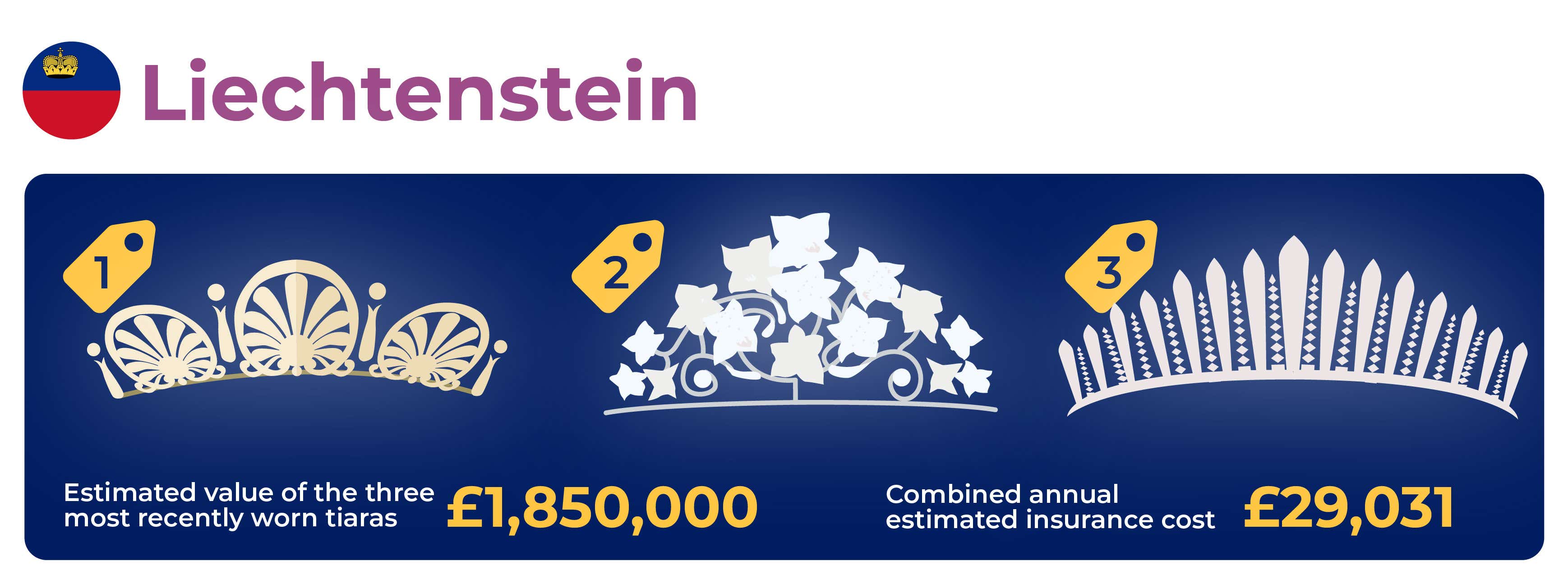
1. Kinsky Honeysuckle Tiara
Valued at £1 million
Worn by Princess Angela of Liechtenstein when marrying Prince Maximilian of Liechtenstein on 29 January 2000.
The Kinsky Honeysuckle Tiara dates back to the 19th-century and is made of honeysuckle motifs in diamond, silver and gold. The honeysuckle designs are surrounded by a halo of diamonds, and each element is separated by a vertical floral design.
This floral tiara belonging to Princess Angela has been valued at £1 million. Our analysis found it could cost the royal family £15,692 to insure each year.
2. The Savoy Ivy Wreath Tiara
Valued at £500,000
Worn by Princess Maria-Pia when marrying Prince Alexander of Yugoslavia on 12 February 1955.
The Savoy Ivy Wreath Tiara is made from a gold baroque brooch, featuring a diamond and pearl stomacher belonging to Princess Maria-Pia’s grandmother, Queen Elena of Italy. Visually it resembles an ivy wreath when donned on the head of the wearer.
Worn at her wedding to Prince Alexander of Yugoslavia in 1955, the Savoy Ivy Wreath Tiara has been valued at half a million pounds. As a result, it could potentially cost £7,846 to insure per annum.
3. The Habsburg Fringe Tiara
Valued at £350,000
Worn by Countess Marie Aglaë von Wchinitz when marrying Prince Hans-Adam on 30 July 1967.
The Habsburg Fringe Tiara was made in around 1890 in Vienna by Köchert – an imperial court jeweller. The headpiece is made of diamonds set in silver and gold and can also be worn as a necklace, like many fringe tiaras.
Often described as the grandest tiara in the family’s collection, the Habsburg Fringe Tiara is frequently worn at major royal events. It has been valued at £350,000, which means it could cost the royal family £5,492 to insure each year.
Which royal tiara has the highest estimated value?

According to the 24 tiara valuations by Steven Stone, the royal tiara with the highest estimated value is the Greville Emerald Kokoshnik Tiara worn by Princess Eugenie of York on her wedding day on October 12th, 2018. The tiara, belonging to the British royal family, is estimated to be worth £10 million and could cost £174,980 to insure every year.
The headpiece with the second highest estimated value, and the second costliest to insure, is Queen Maud’s Diamond Tiara. The headpiece, belonging to the Norweigan royal family, is also valued at an estimated £10 million, but costs an estimated £18,000 less than the Greville Emerald Kokoshnik Tiara to insure annually (£156,923).
Queen Juliana’s Rose Cut Diamond Bandeau has the third highest estimated value of the tiaras studied, according to our expert valuations. Valued at an estimated £8 million, the Dutch tiara could cost £125,538 per year to insure.
Cover your jewels with home insurance
According to ONS crime statistics, jewellery and watches are among the most popular items stolen during home burglaries. Having a comprehensive contents insurance policy can protect you and your precious jewels should your home be broken into.
If you're a homeowner, you may want to consider taking out combined buildings and contents insurance, as UK home insurance providers often offer cheaper premiums compared to having two separate policies.
Methodology
Money.co.uk compiled a list of 8 countries with active royal families who have had three recent royal weddings.
They then found each tiara worn by each royal at their own wedding.
StevenStone.co.uk valued the tiaras based on the number and quality of jewels and materials used, as per the current British market.
Money.co.uk then estimated the insurance premiums using estimations from assetsure.com, which accounted for the age of each royal family member, using the postcode for Buckingham Palace (SW1A 1AA) for consistency.
To determine the estimated annual insurance premium for each tiara, and to find out which royal family could potentially spend the most on insuring their tiara collections, univariate regression was performed based on calculations from StevenStone.co.uk, multiplied by estimate insurance premium cost variables for each tiara.
